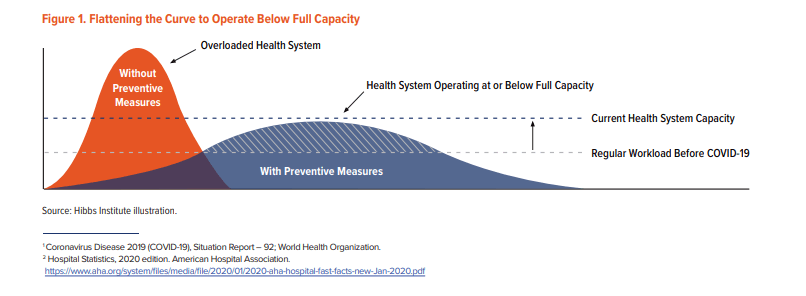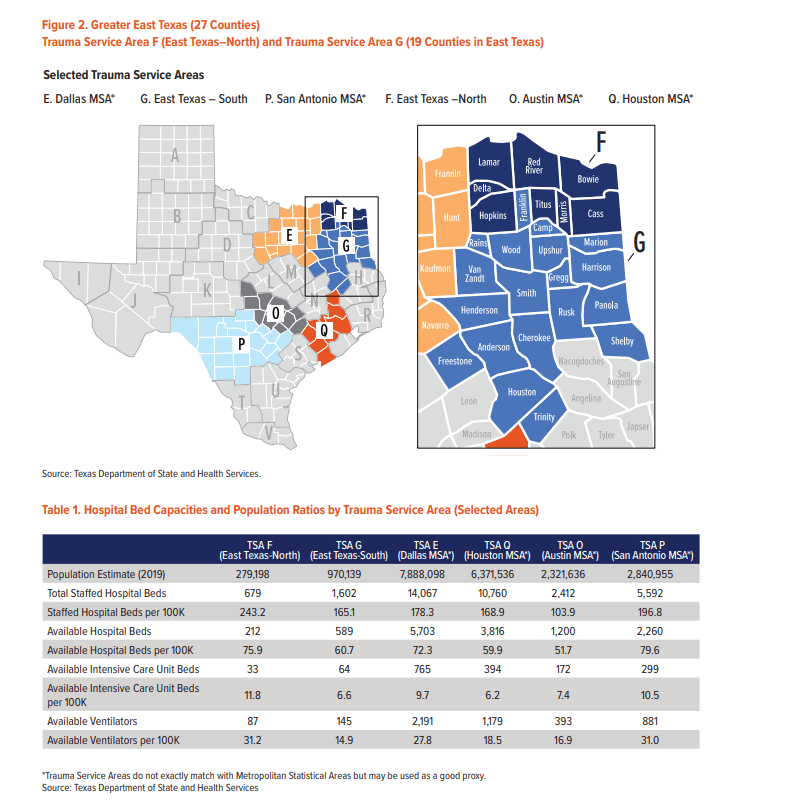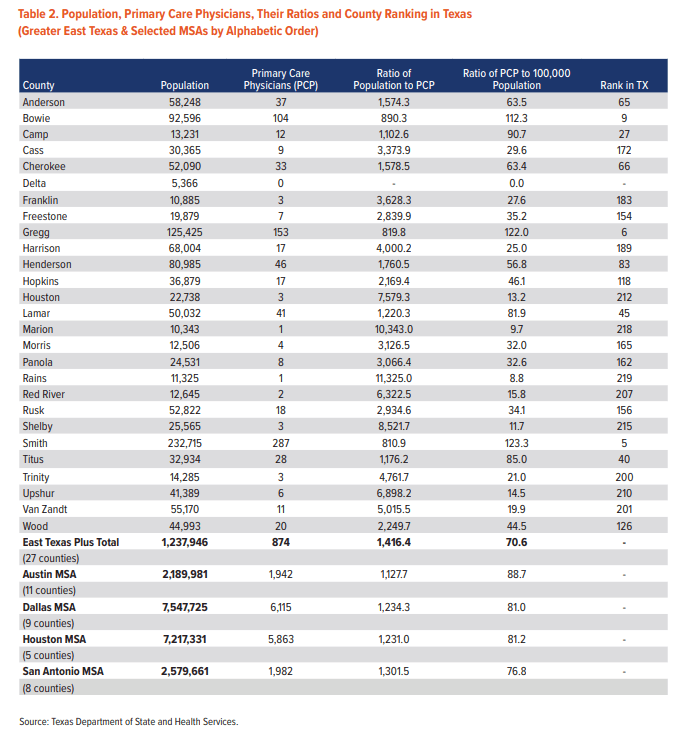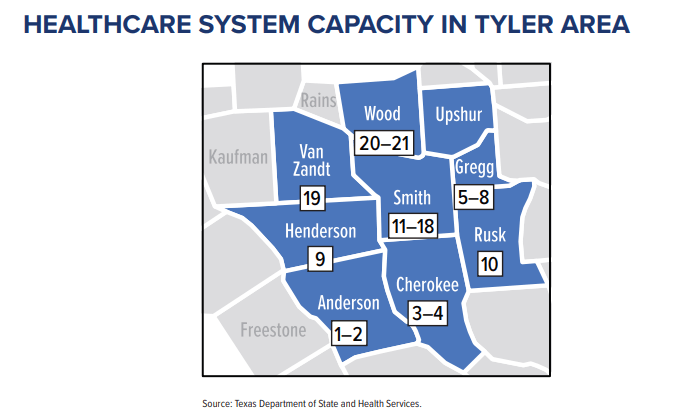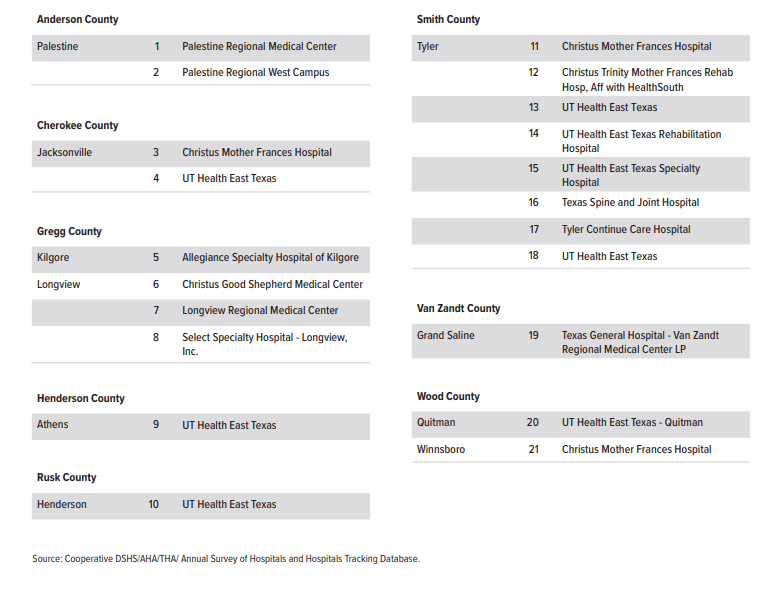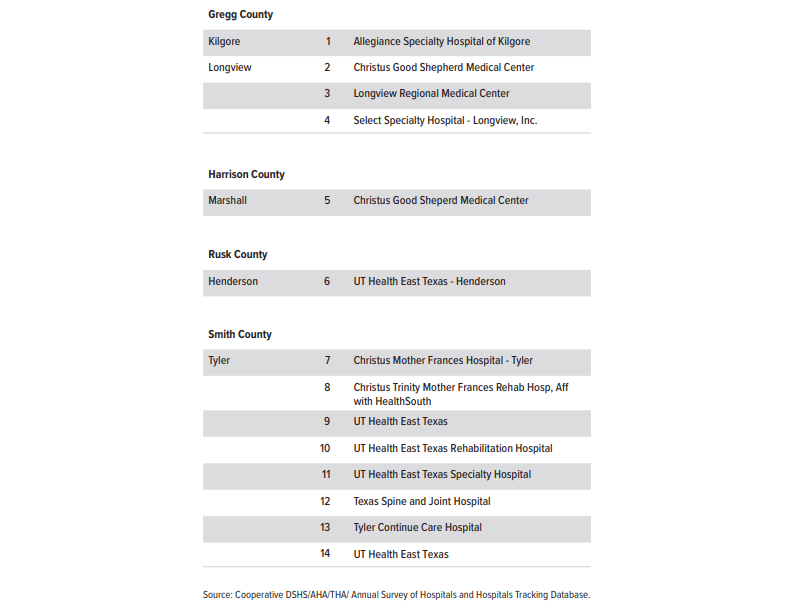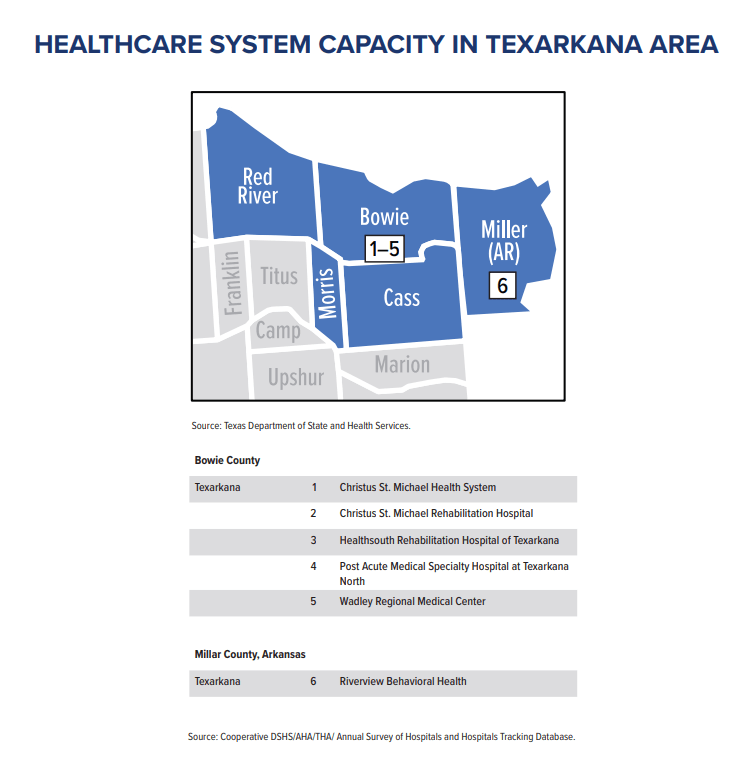Smith, Gregg Counties Lead Large Texas MSAs In Healthcare System Capacity Per Capita
UT Tyler Hibbs Institute for Business & Economic Research • May 4, 2020
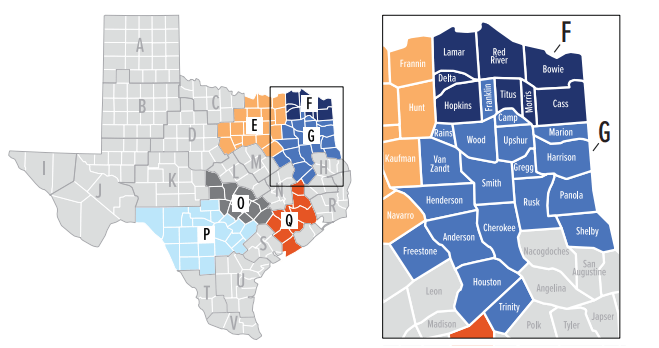
In the wake of the COVID–19 pandemic, healthcare systems in areas that have seen dramatic spikes in illness from the novel coronavirus have been significantly strained. How well positioned is the East Texas healthcare infrastructure to handle the pandemic, and how does East Texas compare to the rest of the state? This issue of the Hibbs Newsletter discusses the healthcare system capacity in Greater East Texas. The Hibbs Institute finds that Smith and Gregg Counties have a robust healthcare system that rivals large Texas MSAs when capacity is evaluated on a per capita basis.
The number of confirmed COVID–19 cases this week in the US has hit 1 million, which is 36 percent of the worldwide cases (2.8 million). Fatality rates caused by COVID-19 itself can increase significantly in any given area if an affected patient with severe symptoms does not have the medical aid required to overcome the illness.
Since COVID–19 is highly contagious, most of the world has taken significant steps to contain or slow the spread of the virus. The term “flattening the curve” describes a phenomenon where restriction of social contact reduces the impact at any one time on a healthcare system. Assuming a large number of individuals will contract COVID–19, these individuals would not be sick at the same time so as not to exceed healthcare system capacity. The more COVID–19 cases can be distributed in the following months, the better medical assistance can be provided; lowering the fatality rate (Figure 1).
Healthcare system capacity varies widely across the globe. The typical variables used to measure the healthcare system capacity are the number of physicians and the number of hospital beds per 100,000 population. For
instance, the US has 924,107 staffed beds in all hospitals (6,146); equaling 281.5 beds per 100,000 population. Compared with other nations, this number may be considered relatively high and efficient under normal circumstances.
So what is the healthcare system capacity here in East Texas? For Smith and Gregg counties in particular, the capacity is favorable. The UT Tyler Hibbs Institute further describes how the capacity is determined.
Trauma Services Areas in Greater East Texas
The Texas Department of State and Health Services classifies the 254 counties in Texas into 22 trauma service areas (TSAs). The department grouped areas with relatively low hospital bed capacities (typically rural) with well-endowed areas. This grouping describes how the healthcare system may provide the necessary medical assistance to Texas residents during times with high usage, as you may find during a pandemic. (Table 1). The Hibbs Institute uses the TSA classification to compare the healthcare system capacities in selected TSA areas.
Within the area labeled Greater East Texas, trauma service area F includes eight counties, while trauma service area G includes 19 counties. Both service areas combined (27 counties) include the Hibbs Institute influence area (23 counties in East Texas) plus four counties: Freestone, Houston, Shelby and Trinity (Figure 2).
Healthcare System Capacity in Greater East Texas
The healthcare system capacity is considerably different from county to county in Greater East Texas. The ratios between population and primary care physicians (PCP) are common variables used to measure the capacity. For instance, the ratio of population to PCP in Smith County is 810.9, or 811 (Table 2). This ratio means that the county has one primary care physician for every 811 individuals. A smaller number implies a larger capacity. In contrast, Van Zandt County shows a similar ratio of 5,015.5, meaning that the county has one primary care physician for every 5,015 individuals.
While the most populated counties in Greater East Texas (Smith, Gregg and Bowie) have outstanding positions in the state ranking (fifth, sixth and ninth, respectively), counties such as Rains, Marion and Shelby rank among the bottom 50 out of 254 Texas counties. Remarkably, Smith, Gregg and Bowie counties show significantly better ratios than large metropolitan statistical areas (MSAs) in Texas (Dallas, Houston, Austin and San Antonio). They are included in the following information graphic for comparison. As of Tuesday, there are 53 active cases in Smith County and 74 active cases in Gregg County, according to the Northeast Texas Public Health District. By comparing the number of cases to PCP, the data shows that both counties are well-positioned to overcome this pandemic.
Source: UT Tyler Hibbs April Newsletter

Executive Director David Cleveland has named Luke Kimbrough as the new Regional Lending Manager for the East Texas Council of Governments (ETCOG). In this role, Kimbrough will oversee the day-to-day operations of the East Texas Regional Development Company’s (ETRDC) small business loan programs. He will work closely with the ETRDC Board, manage financial and administrative services, and ensure the program follows all state and federal guidelines. Kimbrough brings with them more than seven years of experience in banking and employee benefits. Before accepting this position, Kimbrough served as CEO of the Banking Center at Citizens Bank in Gladewater. His previous roles include Vice President at First National Bank of Hughes Springs in Liberty City, Benefits Consultant for Colonial Life in Longview, and Branch Manager for Regions Bank in Kilgore. Before his banking career, Mr. Kimbrough served for several years as the Director of Public Information and Regional Services at ETCOG. “It is a great pleasure for me to welcome Luke back to the ETCOG Family! His exceptional work in the banking community for many years position him for even greater success with our ETRDC Business Lending Programs. I am glad he is back and am even more excited to see the steady growth and expansion of one of our most important economic development programs that will undoubtedly occur under his leadership!” said Executive Director David Cleveland. “I am excited to come back to ETCOG and the East Texas Regional Development Company,” said Kimbrough. “Spending the last decade in banking, I have gained much more experience in financial analysis and commercial lending. There is a lot of work ahead to help the businesses and economy of East Texas.” The ETRDC is a nonprofit organization that is certified and regulated by the U.S. Small Business Administration. Its main purpose is to support local economic development by helping small businesses access long-term, fixed-rate financing. ETRDC offers financing through the SBA 504 Loan Program and Chapman Loan Program.

The East Texas Regional Development Company will sponsor an East Texas Lenders Roundtable hosted by UT Tyler-Longview Small Business Development Center (SBDC) and the Small Business Administration to discuss SBA 7a loans and 504 lending basics. Expert panelists will discuss various loan programs and resources to help businesses increase their portfolios and obtain financing.

The Office of the Governor has announced the launch of a new recovery program, the Texas Travel Industry Recovery Grant Program (TTIR), which will begin accepting applications on July 6, 2022. The purpose of this program is to provide grants to Texas businesses in the tourism, travel, and hospitality industry that were negatively impacted due to COVID-19.
